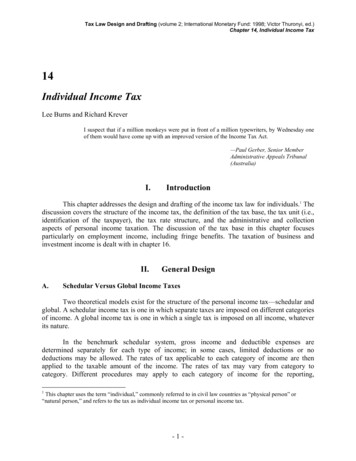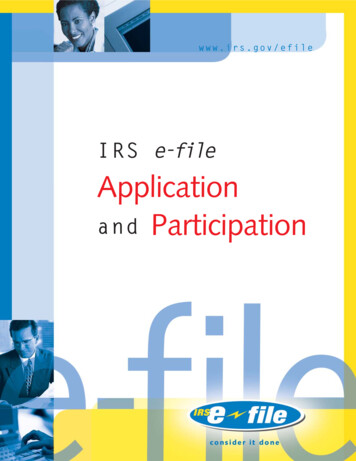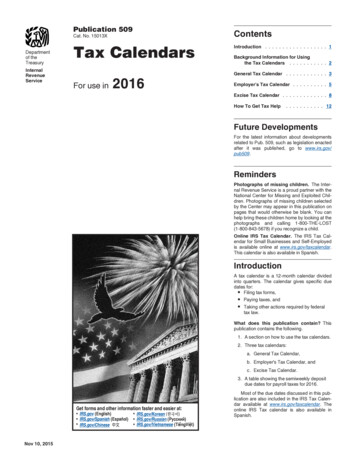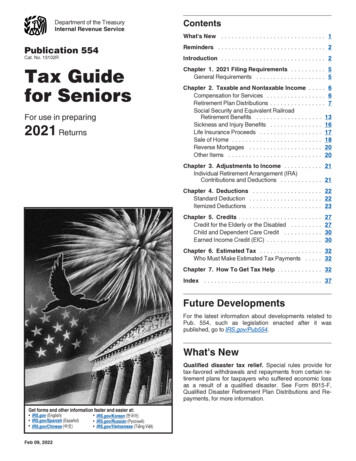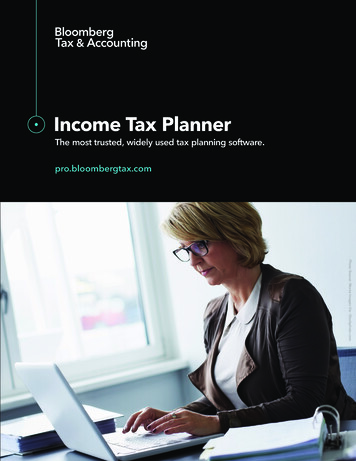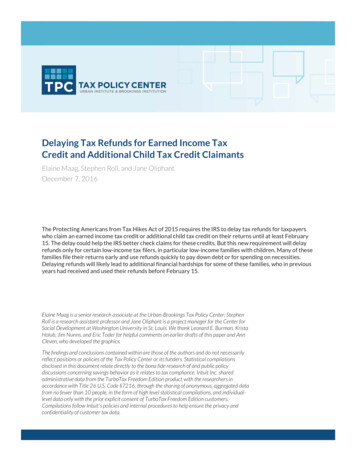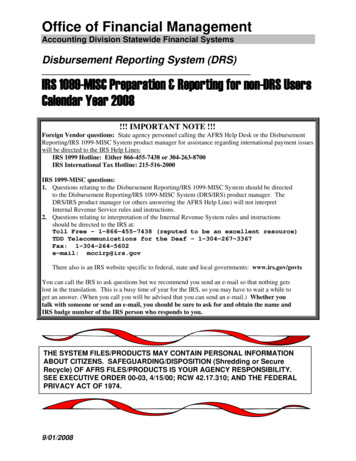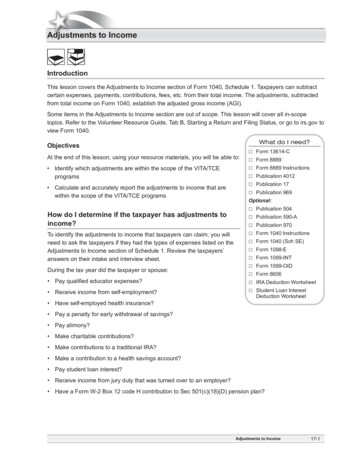
Transcription
Adjustments to IncomeIntroductionThis lesson covers the Adjustments to Income section of Form 1040, Schedule 1. Taxpayers can subtractcertain expenses, payments, contributions, fees, etc. from their total income. The adjustments, subtractedfrom total income on Form 1040, establish the adjusted gross income (AGI).Some items in the Adjustments to Income section are out of scope. This lesson will cover all in-scopetopics. Refer to the Volunteer Resource Guide, Tab B, Starting a Return and Filing Status, or go to irs.gov toview Form 1040.What do I need?ObjectivesAt the end of this lesson, using your resource materials, you will be able to: Identify which adjustments are within the scope of the VITA/TCEprograms Calculate and accurately report the adjustments to income that arewithin the scope of the VITA/TCE programsHow do I determine if the taxpayer has adjustments toincome?To identify the adjustments to income that taxpayers can claim, you willneed to ask the taxpayers if they had the types of expenses listed on theAdjustments to Income section of Schedule 1. Review the taxpayers’answers on their intake and interview sheet.During the tax year did the taxpayer or spouse: Pay qualified educator expenses? Receive income from self-employment? Have self-employed health insurance? Form 13614-CForm 8889Form 8889 InstructionsPublication 4012Publication 17Publication 969Optional: Publication 504Publication 590-APublication 970Form 1040 InstructionsForm 1040 (Sch SE)Form 1098-EForm 1099-INTForm 1099-OIDForm 8606IRA Deduction WorksheetStudent Loan InterestDeduction Worksheet Pay a penalty for early withdrawal of savings? Pay alimony? Make charitable contributions? Make contributions to a traditional IRA? Make a contribution to a health savings account? Pay student loan interest? Receive income from jury duty that was turned over to an employer? Have a Form W-2 Box 12 code H contribution to Sec 501(c)(18)(D) pension plan?Adjustments to Income17-1
Please refer to the Legislative Extenders lesson in this publication for information regarding tuition and feesdeduction.There are other adjustments to income, such as self-employed SEP, SIMPLE, and qualified plans anddomestic production activities deductions. These are beyond the scope of the VITA/TCE programs. If youbelieve a taxpayer could benefit from one of these other adjustments, encourage the taxpayer to consult aprofessional tax preparer.Tax Software Hint: To review the tax software entry screen for Adjustments, go to the VolunteerResource Guide, Tab E, Adjustments.How do I handle educator expenses?Who is eligible?Eligible educators can deduct up to 250 of qualified expenses paid during the tax year. If the taxpayer andspouse are both eligible educators, they can deduct up to 500, but neither can deduct more than their ownexpenses up to 250. The deduction amount is indexed for inflation, so future maximum deduction amountsmay be higher.If the taxpayer or spouse is an educator, probe a little deeper to see if they qualify for this adjustment. Askquestions such as: Are you or your spouse a teacher, instructor, counselor, principal, or aide in a school? (Cannot be ahome school) What grade or grades do you teach? (Must be K-12) Were you employed for at least 900 hours during the school year? (Required minimum)What expenses qualify?If the taxpayer or spouse is an eligible educator, ask about their qualified expenses. Advise taxpayers thatthey must have receipts for verification if they get audited.Expenses that qualify include books, supplies, equipment (including computer equipment, software, andservices), and other materials used in the classroom. The educator’s own professional developmentexpenses related to the curriculum in which the educator provides instruction are also included. Qualifiedexpenses don’t include expenses for home schooling or for nonathletic supplies for courses in health orphysical education.exampleGloria is a 5th and 6th grade teacher who works full-time in a year-round school. She had 1800 hoursof employment during the tax year. She spent 262 on supplies for her students. Of that amount, 212was for educational software. The other 50 was for supplies for a unit she teaches sixth graders onhealth. Only the 212 is a qualified expense. She can deduct 212.exampleDebbie is a part-time art teacher at an elementary school. She spent 185 on qualified expenses forher students. Because she has only 440 hours of documented employment as an educator during thetax year, she cannot deduct her educator expenses.17-2Adjustments to Income
What other rules apply?Probe to learn if the taxpayer or spouse received reimbursement that would reduce the amount of theireducator expenses. For example, ask: Did you receive reimbursement that is not listed as income on Form W-2? Did you redeem U.S. Series EE or I Savings Bonds where the interest would be tax-free, such asredeeming savings bonds to pay educational expenses? Did you receive a nontaxable distribution from a qualified tuition program (QTP) or a distribution ofnontaxable earnings from a Coverdell education savings account (ESA)?Educator expenses are reduced by any of these applicable reimbursements.How do I report this?Educator expenses are reported in the adjustments section of Form 1040, Schedule 1. Don’t forget toreduce the total educator expenses by any reimbursements, nontaxable savings bond interest, nontaxabledistribution from a QTP, or nontaxable distribution of earnings from an ESA.Taxpayer ExampleBob teaches elementary school. His wife Janet teaches high school chemistry. Here is how a volunteerhelped them determine if they can take the deduction for educator expenses.SAMPLE INTERVIEW.VOLUNTEER SAYS JANET & BOB RESPOND You’ve already mentioned that you both work full-time asteachers, so you may be able to deduct some of the moneyyou spent on qualified educator expenses. Can you tell mehow much you spent, or did you bring your receipts?[Janet] Yes, all teachers keep carefulrecords of their expenses. Here are myreceipts and here are Bob’s.Can you tell me what you purchased? Janet, maybe youcould go first.[Janet] Sure. Three receipts are forquick reference cards for my chemistrystudents. And two are for specialreagents the department doesn’t stock.Your receipts add up to 382. Now, we can count onlythe first 250 of educator expenses, but because you aremarried and filing jointly, we can count up to 250 for Bob.Bob, tell me about your expenses.[Bob] These four receipts are for artsupplies – paint and brushes, as youcan see – and these two are for specialpapers and sculpting clay.Yours total 263. Now, did either of you receive anyreimbursement that is not shown on Form W-2?[Janet] No, we paid these expenses outof our own pockets.[Bob] Wait, now that I think about it, I gotreimbursed 50 for the clay.That would bring your total down to 213.[Janet] Can’t we apply some of myexcess expense to Bob and bring histotal up to 250?No, I’m sorry, each person’s expenses have to stand alone.[Janet] Okay.Adjustments to Income17-3
SAMPLE INTERVIEW.VOLUNTEER SAYS JANET & BOB RESPOND Did you redeem U.S. series EE or I Savings Bonds duringthe tax year?[Janet] No, we didn’t. What if we had?We would complete a form to see what percentage of the[Bob] No, neither of those.tax-free interest should be applied as a reimbursement. Onemore thing: did you receive distributions from a qualifiedtuition program or a Coverdell education savings account?Okay, we can claim 213 for Bob and the maximum 250 for [Janet] No, I think we understand.Janet. That gives you a total of 463 on your joint return asa deduction for educator expenses. Any questions before wego on?[On the intake and interview sheet, indicate that the taxpayers are entitled to the educator expense adjustment.]How do I handle self-employment tax?Self-employed taxpayers can deduct a portion of their self-employment tax from their income. SelfEmployment Tax is covered in the Other Taxes Lesson.Tax Software Hint: The deductible portion of the self-employment tax is automatically calculated onSchedule SE by the software and the deductible portion is carried to adjustments section on Form 1040,Schedule 1. To review information related to the software, go to the Volunteer Resource Guide, Tab E,Adjustments.How do I handle self-employed health insurance deduction?Self-employed taxpayers who reported a net profit on Schedule C for the year may be able to deduct thecost of their health insurance paid as a deduction from their gross income. The insurance plan must beestablished under the trade or business and the deduction cannot be more than the earned income fromthat trade or business. When filing Schedule C, the health insurance policy can be either in the taxpayer’sname, the spouse’s name (if Married Filing Jointly), or in the name of the business.Medicare premiums voluntarily paid to obtain insurance in the taxpayer’s name that is similar to qualifyingprivate health insurance can be used to figure the deduction. The spouse’s Medicare premiums qualifyfor the deduction when Married Filing Jointly even though paid from the spouse’s benefits. Include health,dental, vision, supplemental, limited coverage, and long-term care (LTC) premiums. LTC is limited to thededuction cap for Schedule A, based on age.Self-employed taxpayers cannot deduct payments for medical insurance for any month in which they wereeligible to participate in a health plan subsidized by their employer, a spouse’s employer, or an employerof the taxpayer’s dependent or child under age 27 at the end of the tax year. Taxpayers cannot deductpayments for a qualified long-term care insurance contract for any month in which they were eligible toparticipate in an employer-subsidized long-term care insurance plan.Whose health coverage qualifies?For this purpose, health coverage can be for the taxpayer, spouse, dependents, or the taxpayer’s childunder the age of 27 even though the child is not the taxpayer’s dependent. A child includes a son, daughter,stepchild, adopted child, or foster child.17-4Adjustments to Income
What is the limit on the self-employed health insurance deduction?The self-employed health insurance deduction is limited to the net self-employment profit shown on thereturn reduced by the deduction for one-half of the self-employment tax.exampleCarson is single and has his own business. During the year, he paid qualified health insurance premiumsof 3,000. His Schedule C shows a profit of 5,500 and his self-employment tax deduction is 389 fora net of 5,111 ( 5,500 – 389). The full 3,000 premium paid is deductible as self-employment healthinsurance because it is less than the net profit.When the total health insurance costs exceed the self-employed health insurance deduction limit, a taxpayercan generally include any remaining premiums as an itemized medical expense deduction.What if the insurance was purchased through the Marketplace?Self-employed taxpayers who purchased their coverage from the Marketplace and are eligible for thePremium Tax Credit are out of scope for the VITA/TCE programs.How do I handle penalties on early withdrawal of savings?Taxpayers can adjust their gross income to deduct penalties they paid for withdrawing funds from a deferredinterest account before maturity. Ask if the taxpayer and/or spouse made any early withdrawals during thetax year. If so, ask to see Form 1099-INT, Interest Income, or Form 1099-OID, Original Issue Discount,documenting the penalty. The early withdrawal penalty deduction is reported on Form 1040, Schedule 1.Tax Software Hint: The early withdrawal penalty amount should be entered in the interest incomesection if it is listed on Form 1099-INT. Otherwise, go to the Deductions section, then Adjustments, and clickbegin on the Penalty on Early Withdrawal of Savings or CD line.exampleGloria withdrew 5,000 early from a one-year, deferred-interest certificate of deposit. She had to pay apenalty of three months’ interest. She can claim this penalty amount as an adjustment to income.How do I handle alimony paid?Pre-2019 DivorcesAlimony is a payment to a spouse or former spouse under a divorce or legal separation instrument. Thepayments do not have to be made directly to the ex-spouse. For example, payments made on behalf ofthe ex-spouse for expenses specified in the instrument, such as medical bills, housing costs, and otherexpenses can qualify as alimony. Alimony does not include child support or voluntary payments outside theinstrument. The person paying alimony can subtract alimony payments as an adjustment to income; theperson receiving alimony must treat it as income. A summary of the alimony requirements can be found inTab E, Adjustments, in the Volunteer Resource Guide.When you conduct the interview, ask if the taxpayer paid alimony under a divorce or separation instrument.If so, explain that you need the exact amount, as well as the Social Security number of the recipient,Adjustments to Income17-5
because the recipient must report the payment to the IRS as income and the two amounts must agree. Thedate of the divorce, or a reasonable estimate, is also needed to complete Schedule 1.For additional information on alimony, refer to the Alimony chapter in Publication 17 and Publication 504,Divorced or Separated Individuals.Post-2018 DivorcesAlimony or separate maintenance payments made under a divorce or separation agreement (1) executedafter 2018, or (2) executed before 2019, but later modified if the modification expressly states the repealof the deduction for alimony payments applies to the modification, are no longer deductible. Alimony andseparate maintenance payments received under such an agreement are not included in the gross income ofthe recipient.exampleAnthony was divorced in 2017. Under his divorce instrument, he paid his ex-wife 8,000 during the taxyear. As a favor, he also made 4,000 in payments to cover part of her vehicle lease so she could keepsteady employment. He can take the 8,000 as an adjustment to income. He cannot count the leasepayments because those were payments not required by the divorce instrument.EXERCISESAnswers are at the end of the lesson summary.Question 1: Victoria divorced in 2007. Her divorce settlement states that she must pay her ex-husband 12,000 a year. She is also required to pay his ongoing medical expenses for a condition he acquiredduring their marriage. During the tax year, the medical expenses were 11,400. How much can shededuct as an adjustment to income?A. 12,000B. 11,400C. 23,400D. 600How do I handle IRA contributions?Individual Retirement Arrangements (IRAs) are personal savings plans that offer tax advantages to setaside money for retirement. This section discusses “traditional” IRAs. A traditional IRA is any IRA that is nota Roth or SIMPLE IRA. See the Individual Retirement Arrangements (IRAs) chapter in Publication 17, andPublication 590-A, Individual Retirement Arrangements, for more information on all types of IRAs.Some of the features of a traditional IRA are: Taxpayers may be able to deduct some or all of their contributions to the IRA (depending oncircumstances). Generally, amounts in an IRA, including earnings and gains, are not taxed until distributed. Contributions may be eligible for the retirement savings contributions credit.17-6Adjustments to Income
Although contributions to a Roth IRA cannot be deducted, the taxpayer may be eligible for the retirement savingscontributions credit, discussed in the lesson on Miscellaneous Credits.exampleFred has a traditional IRA account and a Roth IRA account. During the tax year, Fred contributed 2,200to his traditional IRA and 1,000 to his Roth IRA. The most Fred will be able to deduct is the 2,200contribution to his traditional IRA.Based on the intake and interview form, ask the taxpayer about any IRA contributions during the year or thatthey intend to make by the due date of the return.What are the eligibility requirements for an IRA contribution?The taxpayer, and the taxpayer’s spouse if applicable, must meet these eligibility requirements in order tomake an IRA contribution: Types of IRAs: Verify the types of IRAs to which the taxpayer and spouse contributed. Only contributionsto traditional IRAs are deductible. Age limit: Under the SECURE Act of 2019, there is no age limit for either traditional or Roth IRAcontributions effective for tax years beginning after December 31, 2019. Compensation: Individuals must have taxable compensation (i.e., wages, self-employment income,commissions, taxable alimony, or taxable scholarships or fellowships, as shown in Box 1 of Form W-2). Time limits: Contributions must be made by the due date for filing the return, not including extensions.Verify with the taxpayer and spouse that they made the contribution(s) (or will make them) by the duedate of the return.Be sure the taxpayer knows that if a contribution is reported on the tax return but is not made by the deadline,the taxpayer must file an amended return.How much can a taxpayer deduct for an IRA contribution?Generally, you can deduct the lesser of: The contributions to your traditional IRA for the year, or The general limit reduced for Roth IRA contributions made for the same tax yearWhat is the compensation requirement?Compensation is generally the income a taxpayer has earned from working; it also includes taxable alimony,and other forms of earned income. (See Publication 17 for more information on compensation.) Taxpayerscannot make IRA contributions that are greater than their compensation for the year.An IRS certified volunteer preparer must exercise due diligence when preparing or assisting in the preparationof, approving, and filing tax returns. Based on this, volunteers may rely in good faith without requiring certain documents from the taxpayer. However, the volunteer preparer may not ignore the implications of information furnished to,or actually known by, the preparer. The preparer must ask questions if the information furnished appears to be incorrect, inconsistent, or incomplete.Adjustments to Income17-7
If taxpayers file a joint return, and one spouse’s compensation is less than the other spouse’scompensation, the most that can be contributed for that spouse is the lesser of: The general limits, or The total compensation includible in the gross income of both spouses for the year, reduced by:– Traditional IRA contributions for the spouse with the greater compensation– Any contribution for the year to a Roth IRA for the spouse with the greater compensationIn other words, as long as they file a joint return, married taxpayers’ combined IRA contributions cannotexceed their combined compensation, and neither spouse can contribute more than the general IRA limit totheir own IRA.Beginning in 2019, taxpayers can elect to increase their compensation for difficulty of care payments thatare excluded from gross income for the purpose of nondeductible IRA contributions.exampleGene and Sue are married and are both over 50 years old. Gene earned 70,000 and Sue earned 1,500. During the tax year, Gene contributed 3,500 to his traditional IRA and 2,000 to a Roth IRA,making his total contributions 5,500. To figure the maximum contribution to Sue’s IRA, use a totalcompensation of 66,000 (i.e., 71,500 – 5,500). If Gene and Sue file jointly, they can contribute up tothe IRA limit to Sue’s IRA even though her own compensation was just 1,500.Although a person may have IRA accounts with several different financial institutions, the tax law treatsall of their traditional IRA accounts as one single IRA. Inherited IRAs, however, are treated separately. Ifa taxpayer inherits a traditional IRA from a deceased spouse, they can treat the account as their own andmake contributions and rollovers into the inherited account. A taxpayer cannot make a contribution to anIRA they inherited from someone other than a spouse. A surviving spouse who elects to transfer an IRAinherited from their spouse to their own IRA can make contributions to the transferred IRA.exampleBill is 29. He has a traditional IRA account at City Home Savings Bank and another traditional IRAaccount through his stockbroker. He also opened a Roth IRA through his stockbroker. Bill can contributeto any or all of his accounts this year, but the combined contributions for the tax year cannot exceed thelesser of the general IRA limit or his compensation for the tax year.EXERCISES (continued)Question 2: Stan, an unmarried college student working part time, earned 4,500 during the tax year.What is the maximum he can contribute to an IRA?A. 1,000B. 3,500C. 4,500D. 5,500Question 3: Bob and Carol are married and both are 55 years old. They both work and each has atraditional IRA. During the tax year, Bob earned 2,000, and Carol earned 50,000. If they file separatereturns, what is the maximum that Bob can contribute to his IRA? .17-8Adjustments to Income
Are there special rules for certain military personnel?Current or former members of the Armed Forces may qualify for additional retirement benefits. Underthe Heroes Earned Retirement Opportunities (HERO) Act, taxpayers can count tax-free combat pay ascompensation when determining whether they qualify to contribute to either a Roth or traditional IRA. Beforethis change, members of the Armed Forces whose earnings came entirely from tax-free combat pay weregenerally barred from using IRAs to save for retirement.When can IRA contributions be deducted?Deductions can be taken for contributions to traditional IRAs for returns that are in scope. The taxpayer’sdeduction for IRA contributions may be “phased out” (i.e., reduced or eliminated) depending on theirincome, filing status, and whether the taxpayer is covered by a retirement plan at work. The differencebetween the permitted contributions and the IRA deduction, if any, is the taxpayer’s nondeductiblecontribution. Form 8606, Nondeductible IRAs, must be completed for any nondeductible traditional IRAcontributions.If taxpayers do not report nondeductible contributions, all of the contributions to a traditional IRA will betreated as having been deducted. This means all distributions will be taxed when withdrawn unless thetaxpayer can show, with satisfactory evidence, that nondeductible contributions were made.Form 8606 requires basis information in IRAs from prior years and can be complex. If Form 8606 isrequired, refer the taxpayer to a professional tax preparer.How do I determine the deduction amount?The factors that affect whether traditional IRA contributions are deductible include: Whether the taxpayer (or spouse, if filing a joint return) is covered by a retirement plan at work. The taxpayer’s Modified Adjusted Gross Income (MAGI) before taking the deduction. If the taxpayer orspouse is covered by a retirement plan, the deduction amount will be reduced or eliminated if the MAGIon the tax return is above a certain limit.Retirement coverage at workAsk if the taxpayer and/or spouse were covered by a retirement plan at work at any time during the tax year. Ifso, their deduction may be limited. Employees covered by a retirement plan will have Box 13 on Form W-2 checked.Filing status and incomeIf the taxpayer or spouse was covered by an employer retirement plan, they may not be able to deduct thefull amount. Notice that the income limitation amount may be different for each spouse on a joint return, butthat the MAGI computation is the same. This is because if one spouse is covered by a retirement plan butthe other is not, the noncovered spouse will have a higher income limit before their IRA deduction is phasedout.If the MAGI is greater than the income limits, the deduction cannot be taken. If this is the case, explain tothe taxpayers and answer any questions they may have about why the deduction cannot be taken. Thecontribution may still be made, it is just not deductible.Enter the total contributions to traditional IRAs that were made (or will be made) for each spouse (on a jointreturn) by the due date of the return.Adjustments to Income17-9
How do I report the IRA deduction?Report the deduction in the adjustments section of Form 1040, Schedule 1.Tax Software Hint: To review information related to the software, go to the Volunteer ResourceGuide, Tab E, Adjustments.What if the taxpayer has an excess IRA contribution?An excess IRA contribution is an amount contributed to a traditional or Roth IRA that is more than thelesser of: The taxable compensation for the year, or General limit amountThe taxpayer may not know that a contribution qualifies as “excess” until the tax return is completed. Whenthis situation is identified, the excess amount, with any earnings on that amount, must be withdrawn bythe due date of the return (including extensions). If the excess amount is not withdrawn by the due dateof the return, including extensions, the taxpayer will be subject to an additional 6% tax on this amount.This additional tax is covered in the Other Taxes lesson, but is out of scope for the VITA/TCE programs.Taxpayers subject to the additional 6% tax should be referred to a professional tax preparer.When the taxpayer has modest wages or other compensation and traditional or Roth IRA contributions, confirmthat the limit has not been exceeded.The withdrawn excess contribution is not included in the taxpayer’s gross income before the tax return isdue if both of the following conditions are met: No deduction was allowed for the excess contribution All interest or other income earned on the excess contribution is withdrawnIf taxpayers timely filed the tax return without withdrawing a contribution that they made during the taxyear, they can still have the contribution returned to them within 6 months of the due date of the tax return,excluding extensions.Taxpayers must include in gross income the interest or other income that was earned on the excesscontribution. Taxpayers must report it on their return for the year in which the excess contribution was made.The withdrawal of interest or other income may be subject to an additional 10% tax on early distributions.Form 1099-RTaxpayers will receive Form 1099-R indicating the amount of the withdrawal. If the excess contribution wasmade in a previous tax year, the form will indicate the year in which the earnings are taxable.exampleMaria, age 35, made an excess contribution of 1,000, which she withdrew by the due date of her return.At the same time, she also withdrew the 50 income that was earned on the 1,000. She must includethe 50 in her gross income (for the year in which the excess contribution was made). She must also payan additional tax of 5 (the 10% additional tax on early distributions because she is not yet 59½ yearsold), but she does not have to report the excess contribution as income or pay the 6% excise tax. Mariareceives a Form 1099-R showing that the earnings are taxable for the current year.17-10Adjustments to Income
How do I handle Health Savings Accounts?What is an HSA?An HSA is a tax-exempt trust or custodial account that a taxpayer sets up with a qualified HSA trustee.Distributions from an HSA are nontaxable if the funds are used for qualified medical expenses. A taxpayermust be an eligible individual to qualify to contribute to an HSA.Individuals Who Qualify for an HSATo be an eligible individual and qualify for an HSA, the taxpayer must meet the following requirements: Be covered by a high-deductible health plan (HDHP) on the first day of the month Not be covered by other health insurance (see Publication 969 for exceptions) Not be enrolled in Medicare (the individual can be HSA-eligible for the months before being covered byMedicare) Not be eligible to be claimed as a dependent on someone else’s tax return (see Caution)If another taxpayer is entitled to claim the individual as a dependent, the individual cannot claim a deductionfor an HSA contribution. This is true even if the other person does not actually claim the dependent.Rules for Married IndividualsIn the case of married individuals, each spouse who is an eligible individual who wants to have an HSAmust open a separate HSA. Married couples cannot have a joint HSA, even if they are covered by the sameHDHP; however, distributions can be used to cover the qualified expenses of the other spouse.In the event of the death of one of the married individuals, the HSA will be treated as the surviving spouse’sHSA if the spouse is the designated beneficiary of the HSA.An employee covered by an HDHP and a health FSA or an HRA that pays or reimburses qualified medicalexpenses generally cannot make contributions to an HSA.Contributions to HSAAny eligible individual can contribute to an HSA. For an employee’s HSA, the employee, employer, orboth may contribute to the employee’s HSA in the same year. For an HSA established by a self-employed(or unemployed) individual, the individual can contribute. Family members or any other person may alsocontribute on behalf of an eligible individual. Contributions to an HSA must be made in cash. Contributionsof stock or property are not allowed.Amounts contributed to an HSA, except for employer contributions and qualified HSA funding distributionsfrom IRAs, can be used as an adjustment to income for the account owner.Employer ContributionsEmployer contributions (including an employee’s contribution through a cafeteria plan) are allowed to bemade to an employee’s HSA. Generally, employer contributions are excluded from an employee’s income.Employer contributions are reported on Form W-2, Box 12 using code W. Taxpayers must reduce theamount they, or any other person, can contribute to their HSA by the amount of any contributions madeAdjustments to Income17-11
by the ta
IRA Deduction Worksheet Student Loan Interest Deduction Worksheet How do I determine if the taxpayer has adjustments to income? To identify the adjustments to income that taxpayers can claim, you will need to ask the taxpayers if they had the types of expenses listed on the Adjustments to Income section of Schedule 1. Review the taxpayers'


